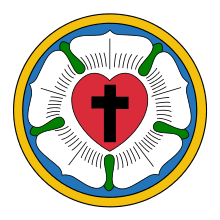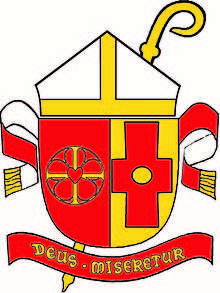Lutheran Church in Great Britain
| Lutheran Church in Great Britain | |
|---|---|
 | |
| Classification | Protestant |
| Orientation | Lutheranism |
| Polity | Episcopal |
| Associations |
The Lutheran Council of Great Britain Porvoo Communion Lutheran World Federation |
| Region | Great Britain |
| Origin | 1961 (as the United Lutheran Synod) |
| Congregations | 11 |
| Official website | http://www.lutheranchurch.co.uk/ |
| Part of a series on |
| Lutheranism |
|---|
 |
|
Bible translators
|
|
Theologians |
|
|
The Lutheran Church in Great Britain (LCiGB) is a relatively small church in the United Kingdom. The LCiGB is a member church of the Lutheran World Federation and of the Lutheran Council of Great Britain (also known as the Council of Lutheran Churches), the umbrella organization for Lutheran churches in Britain, many of which are chaplaincies or congregations which are closely related to churches in other countries, in particular the Nordic countries. The LCiGB is also a member of the Porvoo Communion of Anglican and Lutheran churches in Europe. It is, in common with many Lutheran Churches,[1] led by a Bishop and a Council elected at its Annual Synod. The Right Revd Dr Martin Lind, former Bishop of the Diocese of Linköping in the Church of Sweden, was received as the third Bishop of LCiGB on 11 January 2014.
History
The English Reformation did not follow the Lutheran pattern, but was instead largely influenced by ideas stemming from the Reformation in Switzerland and its parallel in Strasbourg. It is well known that Henry VIII did not favour the Lutheran cause. However, there were some English adherents of Lutheranism. A group in Cambridge, which met at the White Horse tavern from the mid-1520s and became known as Little Germany, were influential. Its members included Robert Barnes, Hugh Latimer, John Frith and Thomas Bilney. Archbishop Thomas Cranmer was initially influenced by Lutheran theology. He visited Andreas Osiander in Nuremberg in 1532. The First Prayer Book of Edward VI (1549) was arguably Lutheran in content. However, the Second Prayer Book of Edward VI (1552) was published along Swiss Reformed lines and the Church of England became part of the Reformed tradition in Protestantism. The first Lutherans living in Britain after the Reformation were therefore not local people, but largely foreign merchants.
The first officially sanctioned Lutheran congregation received a Royal Charter in 1672 from Charles II. Most Lutherans after the Reformation living in Britain were foreign merchants. The charter gave this mostly German congregation the site of the former church of Holy Trinity the Less in the City of London which was destroyed in 1666 in the Great Fire of London. The foundation stone of Holy Trinity Lutheran Church was laid on 21 November 1672 and the completed building was dedicated one year later on Advent Sunday 1673. The church was usually known as the Hamburg Lutheran Church because many of its original members were sea merchants associated with the Hanseatic League from Hamburg, Germany. The church survived until 1871 when it was demolished to make way for the Mansion House underground station.
All Lutheran congregations in Britain were originally ethnic churches that worshipped in various national languages and most that remain still function on ethnic-linguistic lines. The LCiGB was founded as the English-speaking United Lutheran Synod in April 1961 by four congregations in London, High Wycombe, Corby, and Hothorpe Hall. These congregations were mainly founded by European immigrants, but now worshipped in English. In 1978, it changed its name to the Lutheran Church in Great Britain - United Synod. In 1988, the words 'United Synod' were dropped from its name. From 1961-2000, the LCiGB was led by a Dean who had episcopal functions, but was not a consecrated bishop. In 2000, it adopted a fully episcopal polity when the Right Revd Walter Jagucki was consecrated as the first Bishop. In 2013, the LCiGB was accepted by the Presiding Bishops of the Porvoo Communion for full membership,[2] and it was admitted into the Communion when Bishop Martin Lind signed the Porvoo Declaration in September 2014.[3]
Congregations
There are 11 congregations in the LCiGB as well as three chaplaincies. Although the LCiGB originated as an English-speaking church, it now holds services in several languages. Services are conducted in English (in Birmingham, Bradford, Corby, Harrogate, Leeds, Liverpool, London, Manchester and Nottingham), Chinese (in London), Polish (in Bradford, Edinburgh, High Wycombe, London, Manchester and Reading), Swahili (in London), with a Nordic congregation in Liverpool worshipping in Swedish, Norwegian and occasionally Finnish and Danish. In addition, the LCiGB is active in university chaplaincies at Birmingham University(University of Birmingham Chaplaincy), Leeds University, and Leicester University (University of Leicester Chaplaincy).
Bishops

- Walter Jagucki: 2000-2009[4]
- Jāna Jēruma-Grīnberga: 2009 to 2013
- Martin Lind: since 2014
See also
- Evangelical Lutheran Church of England
- Lutheran Church in Ireland
- Lutheran World Federation
- Porvoo Communion
References
- ↑ "LWF AFFIRMS HISTORIC STATEMENT ON EPISCOPAL MINISTRY". Evangelical Lutheran Church in Canada. Retrieved 8 September 2013.
- ↑ "Communiqué from the meeting of presiding bishops". The Porvoo Communion. 24 October 2014. Retrieved 1 December 2014.
- ↑ "Porvoo Communion grows as two Churches signed the Porvoo agreement". The Porvoo Communion. 19 September 2014. Retrieved 1 December 2014.
- ↑ http://www.webcitation.org/6TWJqY9JW
External links
- Lutheran Council of Great Britain (Council of Lutheran Churches)
- Porvoo Communion
- Lutheran World Federation
Parish Websites
- Nordic Church Liverpool
- St Anne's Lutheran Church in London
- Trinity Lutheran Church, Nottingham
- St Mark's, Birmingham